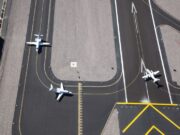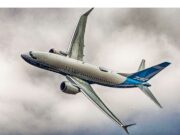
Commercial jets were involved in 12 major accidents worldwide from Jan. 1 through Nov. 12, 2018 — three times as many as were recorded in all of 2017, according to an analysis by Flight Safety Foundation Fellow Jim Burin (Table 1).
A major accident is defined as one in which any of three conditions is met: The airplane was destroyed or the cost of repairs is greater than 50 percent of the cost of the aircraft, or there were multiple fatalities, or there was one fatality and the airplane was substantially damaged.
The 374 fatalities associated with 2018’s five fatal accidents far outstripped the four fatalities in 2017’s only fatal crash, said Burin, who presented his data during the Foundation’s 71st annual International Air Safety Summit, held in November in Seattle.
| Date | Operator | Aircraft | Location | Phase | Fatal | |
|---|---|---|---|---|---|---|
| CFIT = controlled flight into terrain; EXC = runway excursion; LOC = loss of control in flight Source: Ascend — A Flight Global Advisory Service, Jim Burin |
||||||
| 2018 | ||||||
| Jan. 13 | Pegasus Airlines | B-737 | Trabzon, Turkey | Landing | 0 | |
| Feb. 11 | SaratovAirlines | AN-148 | Moscow | Initial climb | 71 | LOC |
| April 17 | SouthwestAirlines | B-737 | Philadelphia | En route | 1 | |
| May 18 | DamojhAerolíneas | B-737 | Havana | Initial climb | 112 | |
| July 31 | AeromexicoConnect | EMB-190 | Durango, Mexico | Takeoff | 0 | |
| Aug. 16 | XiamenAirlines | B-737 | Manila, Philippines | Landing | 0 | EXC |
| Sept. 1 | UTAir | B-737 | Sochi, Russia | Landing | 0 | EXC |
| Sept. 28 | Air Niugini | B-737 | Chuuk, Micronesia | Approach | 1 | CFIT |
| Oct. 10 | Yakutia | Superjet | Yakutsk, Russia | Landing | 0 | EXC |
| Oct. 29 | Lion Air | B-737 | Java Sea, Indonesia | Enroute | 189 | |
| Nov. 7 | SkyLeaseCargo | B-747F | Halifax, Canada | Landing | 0 | EXC |
| Nov. 9 | FlyJamaica | B-757 | Georgetown, Guyana | Landing | 0 | EXC |
| 2017 | ||||||
| Jan. 16 | MyCargoAirlines | B-747 | Bishkek, Kyrgyzstan | Go around | 4 | |
| March 28 | Peruvian Air Line | B-737 | Jauja, Peru | Landing | 0 | |
| July 18 | Tri-MG Airlines | B-737F | Wamena, Indonesia | Landing | 0 | |
| July 29 | CavokAir | AN-74 | San Tome and Principe | Takeoff | 0 | |
Burin’s analysis found that, of the 12 major accidents that occurred before Nov. 12, seven were approach and landing accidents, five involved runway excursions, one involved controlled flight into terrain (CFIT), and one involved loss of control. All four categories have been the subject of years of study — and the focus of programs designed to prevent such accidents. (Some accidents fell into more than one category.)
“One of the best things we do is develop interventions” through improvements in training, technology, regulations and other areas,” Burin said. “But what we’re really not good at always is implementing them. … We need to make sure that the interventions we have worked so hard to create are being used.”
A decade-by-decade comparison shows that the major accident rate for worldwide commercial jets has declined from 6.21 major accidents per million departures in the 1960s to 0.57 per million departures in the 2000s (Figure 1). So far in the decade that will end in 2019, the major accident rate is 0.27 per million departures. In 2018, the rate through Nov. 12 was 0.32 accidents per million departures.
Figure 1 — Major Accident Rates by Decade, Worldwide Commercial Jets, 1960–2017
Source: Jim Burin
Burin noted that each decade, the accident rates have been cut approximately in half, and that the last six years have produced the six lowest accident rates in history.
“That is not hard when the accident rate is over 6 [per million departures], but when it gets under 1, then it is more difficult,” he said.
Three of 2018’s commercial jet major accidents were classified as upset aircraft accidents — those in which an airplane pitches more than 10 degrees nose-down or more than 25 degrees nose-up, rolls to more than 45 degrees of bank or is flown at an airspeed that is inappropriate for flight conditions. Upset major accidents have generally been decreasing in recent years, since they peaked at six accidents in 2008. Numbers dropped to four in 2009, three in 2010 and zero in 2011 and 2012. Between 2013 and 2017, no more than two upset major accidents were recorded in any single year.
Burin’s data include all scheduled and unscheduled passenger and cargo flights in Western-built and Eastern-built commercial turbojets and turboprops equipped with more than 14 seats or with a maximum takeoff weight of more than 12,500 lb (5,670 kg); Western-built airplanes account for 98 percent of the worldwide fleet of 27,951 turbojets and 85 percent of the 5,418 turboprops. Thus far in 2018, Eastern-built jets, which account for 2 percent of the fleet, were involved in 16 percent of the major accidents.
Eastern-built turboprops, which account for 15 percent of the turboprop fleet, were involved in three of five turboprop accidents that occurred through Nov. 12 (Table 2). Of the five accidents, two involved CFIT, compared with three turboprop CFIT crashes each year from 2015 through 2017; nevertheless, numbers have declined from seven CFIT turboprop crashes in 2014 and eight in 2013.
| Date | Operator | Aircraft | Location | Phase | Fatal | |
|---|---|---|---|---|---|---|
| CFIT = controlled flight into terrain Source: Ascend — A Flight Global Advisory Service, Jim Burin |
||||||
| Feb. 18 | Iran Aseman | ATR-72 | Yasuj, Iran | Approach | 66 | CFIT |
| March 12 | US-Bangla Airline | DHC-8 | Kathmandu, Nepal | Landing | 51 | |
| June 24 | Eagle Air | LET-410 | Sougeta, Guinea | En route | 4 | |
| July 20 | Kaz Transair | AN-26 | Al Alamain, Egypt | En route | 0 | |
| Sept. 9 | Slaver Company | LET-410 | Yirol, South Sudan | Approach | 20 | CFIT |
Four of this year’s five turboprop accidents involved fatalities, with a total of 141 people killed.
Over the five years from 2013 through 2017, turboprop major accidents averaged 17.8 accidents per year, Burin said, noting that Eastern-built turboprops continue to account for a significant number of accidents (Figure 2).
Figure 2 — Turboprop Major Accidents, 2001–2017
Source: Jim Burin
Burin noted one other accident that does not fall into any of the categories he cited, reasoning that the number of fatalities was too great to ignore — the Aug. 4 crash of a vintage Junkers JU-52, manufactured in 1939 and operated on sightseeing flights. Twenty people were killed when the airplane crashed in Switzerland.
Six of the worldwide fleet of 20,104 business jets were involved in accidents from Jan. 1 through Nov. 12; three of the accidents resulted in a total of 14 fatalities (Table 3).
| Date | Operator | Aircraft | Location | Phase | Fatal |
|---|---|---|---|---|---|
| Source: Ascend — A Flight Global Advisory Service, Jim Burin | |||||
| Jan. 11 | Basaran Holdings | Challenger 604 | Shahr-e-Kur, Iran | En route | 11 |
| April 2 | Avis Industrial | Citation CJ4 | Marion, Indiana, U.S. | Landing | 0 |
| April 15 | Augusta Aviation | Citation 525 | Crozet, Virginia, U.S. | En route | 1 |
| May 22 | Private | Gulfstream 200 | Tegucigalpa, Honduras | Landing | 0 |
| Aug. 7 | Alliance Air Charter | Falcon 20 | Penasco, Mexico | Approach | 0 |
| Sept. 27 | Global Aircraft | Falcon 50 | Greenville, South Carolina, U.S. | Landing | 2 |
The total of six accidents marked a downturn from the 10 business jet major accidents recorded in 2017, as well as the 2013–2017 five-year average of 9.2 accidents per year, Burin said.



